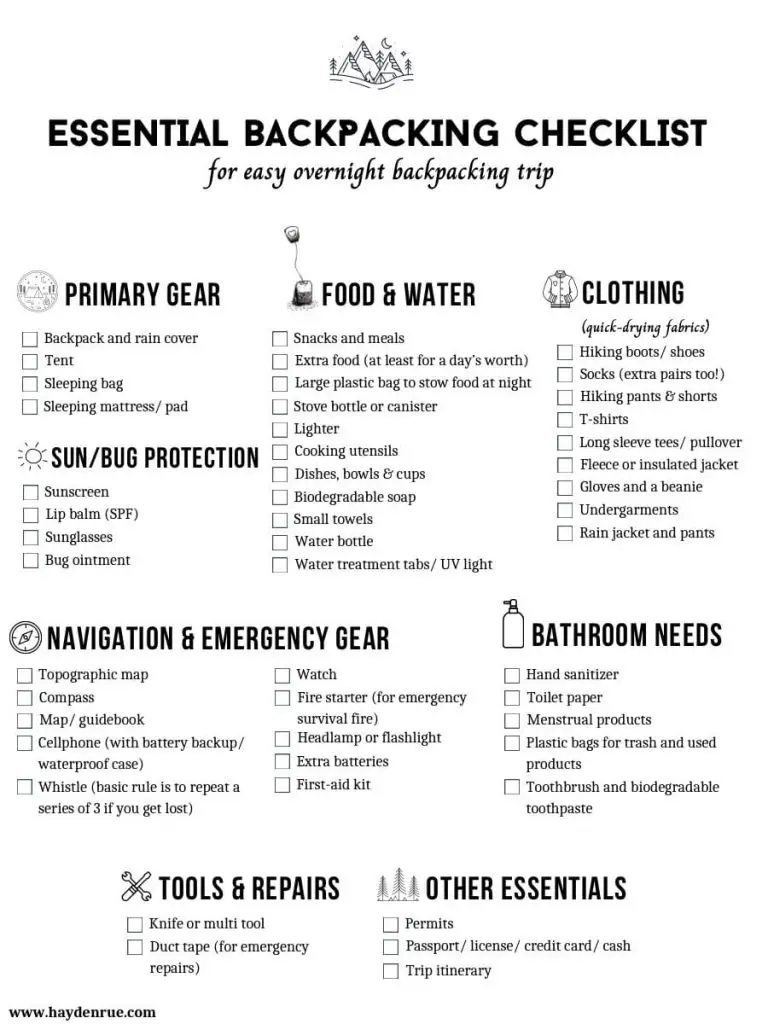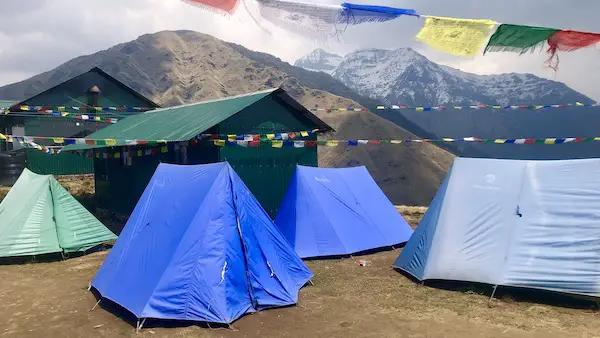Backpacking embodies the ultimate outdoor adventure, where you venture onto the trail with only life’s essentials strapped to your back. And if you are like me, it takes you to some of the best treks in Nepal! However, you can not simply just get up and go, without packing properly. That’s why a Backpacking Checklist is so essential!
To ensure a successful backpacking trip, consider the distance you intend to hike, the remoteness of the location, and the upcoming weather forecast. As a general rule, the longer or more remote the hike and the harsher the weather conditions, the greater the need for clothing, equipment, nourishment, and hydration. If you’re new to backpacking, it’s highly recommended that you read Backpacking for Beginners before embarking on your journey.
Backpacking Checklist: Essentials for Backpacking
The 12 items should be apart of the gear you carry on every backpacking journey:
- Hiking boots or shoes
- Backpack
- Tent
- Sleeping bag and sleeping pad
- Stove and fuel
- Kitchen supplies
- Plenty of food
- Water bottles and water-treatment supplies
- Weather-appropriate clothing
- Emergency and hygiene supplies
- Small repair kit
- The Ten Essentials

How to Use This Backpacking Checklist:
Utilize this practical backpacking checklist while packing to ensure that you remember all essential items. Here are some guidelines to optimize its usage:
- The Ten Essentials: Items designated as part of the Ten Essentials are marked with an asterisk (*). The specific items you choose should be tailored to your trip, taking into account hiking factors such as weather conditions, difficulty level, duration, and distance from assistance.
- This checklist is intentionally comprehensive: It is designed for backcountry excursions where self-sufficiency is crucial for your well-being. When planning for backpacking trips, it is vital to strike a balance between minimizing pack weight and ensuring that you have all the necessary items for your specific journey.
- Download or save the Checklist: So you can access the guide in a hurry, download or save the backpacking checklist. That way you know exactly what you need while packing or shopping for gear!
Backpacking Gear:

For overnight adventures, a backpacking pack with a capacity of 30-50 liters is generally suitable. However, if you plan to be out in the wilderness for two or three nights, it is advisable to opt for packs towards the higher end of that range. If you are looking for the best backpacks for hiking and trekking, check out my review blog (linked below!). It also contains info on how to choose a backpack.
Now let’s take a look at the backpacking gear on this checklist you will need.
Necessary Gear:
- Backpack with rain cover (check out our best hiking and trekking backpack review blog!)
- Backpacking tent (with stakes, guylines)
- Sleeping bag (with stuff sack)
- Sleeping pad
- Headlamp or flashlight * (with extra batteries)
Optional Gear:
- Trekking poles
- Packable lantern
- Tent footprint (for extra floor protection)
- Pillow
- Bear spray
Kitchen Equipment and Utensils:
Since you will be staying overnight out in the wilderness, you will need some kitchen utensils and equipment to cook your meals. Make sure you have the following kitchen gear from the checklist:
- Backpacking stove
- Fuel
- Cookset (with pot grabber)
- Dishes/bowls
- Eating Utensils
- Mug/cup
- Biodegradable soap
- Small quick-dry towel
- Collapsible water container
- Bear canister/food sack; or hang bag + 50′ nylon cord
Food and Water for Backpacking:
When preparing for the trail, ensure you pack convenient snacks such as energy bars, jerky, hard cheeses, and nuts that can be easily consumed while on the move. For lunch, allocate time for a more substantial snack break.
Determining your water-carrying requirements necessitates careful consideration of the available water sources in your intended destination. As a general guideline, it is recommended to consume approximately half a liter of water per hour during moderate activity in moderate temperatures.
It is also important to know which type of adventure you are planning on going on, as you will need different amounts of food and water, for a hike or trek. Check out our blog hiking vs trekking: whats the difference, to know more about each activity.
- Water bottles and/or reservoir *
- Water filter/purifier or chemical treatment *
- Meals
- Energy food and drinks (bars, gels, chews, trail mix, drink mix)
- Extra day’s supply of food *
Clothing and Footwear while hiking:

Before embarking on your adventure, check the weather forecast and dress accordingly to match the conditions. To be adequately prepared for unpredictable weather or unexpected overnight stays, pack additional clothing beyond what is strictly necessary for your trip.
Additionally, take into account the level of sun protection offered by your clothing to safeguard against ultraviolet rays. When it comes to footwear, select the appropriate option based on the terrain you will encounter. For gentle hikes on smooth trails, hiking shoes or trail runners are typically suitable. However, if you anticipate rocky and rugged trails, boots will provide better support. To gain further insights into selecting the right hiking clothing and footwear, check out our guide on how to choose a hiking boot.
Necessary Clothing and Footwear
- Moisture-wicking underwear
- Moisture-wicking T-shirt
- Quick-drying pants/shorts
- Long-sleeve shirt (for sun and bug protection)
- Lightweight fleece or jacket
- Appropriate boots or shoes for the terrain
- Synthetic or wool socks
- Extra clothes * (beyond the minimum requirement)
Additional items for rainy and/or cold weather:
- Rainwear (jacket and pants)
- Long underwear
- Warm, insulated jacket or vest
- Fleece pants
- Gloves or mittens
- Warm hat
Optional clothing and footwear:
- Sandals (for fording streams and/or camp shoes)
- Bandana or Buff
- Gaiters (for rainy, snowy or muddy conditions)
Navigation Gear for your Backpacking Checklist:
Navigation is an integral part of the Ten Essentials system. The specific items you include will depend on the nature of your trip and your personal preferences. However, it’s important to note that while a GPS can be useful, it should not be relied upon as a sole substitute for a map and compass.
- Map * (preferably inside a waterproof sleeve)
- Compass *
Optional navigational equipment:
- Route description or guidebook
- Watch
- GPS *
- Satellite messenger/personal locator beacon *
- Smart Phone
Note: Many of us rely on our smart phones for everything now. Your smartphones may work out in the wilderness, but service is never guaranteed. Moreover, the battery and backup power banks may die as well. A smartphone can be a great tool to help navigate, but it shouldn’t be the only navigational tool from the backpack checklist you rely on.
Emergency and First Aid:
Including an emergency shelter is crucial as part of the Ten Essentials. Even if you already have a tent in your gear, it is still important to carry an emergency shelter, especially if you intend to embark on day hikes away from your base camp. This additional shelter ensures that you are prepared for unforeseen circumstances and provides an extra layer of safety during your outdoor adventures.
Necessary Emergency and First Aid Gear
- First-aid kit or first-aid supplies * (see First-Aid Checklist)
- Whistle
- Lighter/matches (in waterproof container) *
- Fire starter (for emergency survival fire) *
- Emergency shelter *
- Two itineraries: 1 left with friend + 1 under car seat
Health and Hygiene:
- Hand sanitizer
- Toothbrush and toothpaste
- Sanitation trowel
- Toilet paper/wipes and sealable bag (to pack it out)
- Menstrual products
- Prescription medications
- Prescription glasses
Sun protection:
- Sunglasses * (+ sunglass straps)
- Sunscreen
- SPF-rated lip balm *
- Sun hat *
Optional:
- Insect repellent *
- Urinary products
- Additional blister treatment supplies
Tools and Repair Items on the Checklist:
Below are a couple of repair items you should consider bringing. These will help in case of an emergency, or if you need to manufacturer/repair something while hiking:
- Knife or Multi-tool *
- Repair kit (include mattress/stove supplies) *
- Duct tape strips
Optional Backpacking Gear:
The items listed below are all optional, and it is up to you to determine the weight you are willing to carry if you choose to include any of them in your gear.
- Daypack (for day trips away from camp)
- Camera or action cam (with extra memory cards and batteries)
- Interpretive field guide(s)
- Star chart/night-sky identifier
- Outdoor journal with pen/pencil
- Book/reading material
- Cards or games
- Compact binoculars
Personal Items while Backpacking:
- Permits (if needed)
- Credit card and/or cash
- ID
- Car keys
- Cellphone
- Trekking and Hiking Insurance (insurance is only required in some places like Nepal. However, it can come in handy if you are trekking and hiking while abroad.)
Note: Items marked with a (*) are integral components of the Ten Essentials for backpacking. The specific items you select for each should be customized according to factors such as weather conditions, difficulty level, trip duration, and proximity to assistance.
The Ultimate Backpacking Checklist for hikers and trekkers
The Ultimate Backpacking Checklist serves as an invaluable resource for hikers and trekkers embarking on their outdoor adventures. By utilizing this comprehensive checklist, you can ensure that you have all the essential items needed for a successful and safe backpacking experience.
From selecting the appropriate backpack size to packing the right clothing, gear, and nourishment, the checklist guides you through every aspect of preparation. If you need help choosing the right bag volume, check out our what size of backpack do I need guide! It emphasizes the importance of considering factors such as weather conditions, trip duration, and terrain, allowing you to tailor your bag choice accordingly.
Additionally, the checklist reminds you to prioritize navigation, emergency shelter, and water management as part of the Ten Essentials systems. By following this checklist, you can optimize your backpacking experience, enhance your self-sufficiency, and confidently explore the great outdoors with peace of mind. So, before you embark on your next backpacking journey, be sure to refer to the Ultimate Backpacking Checklist and embark on your adventure fully prepared.
